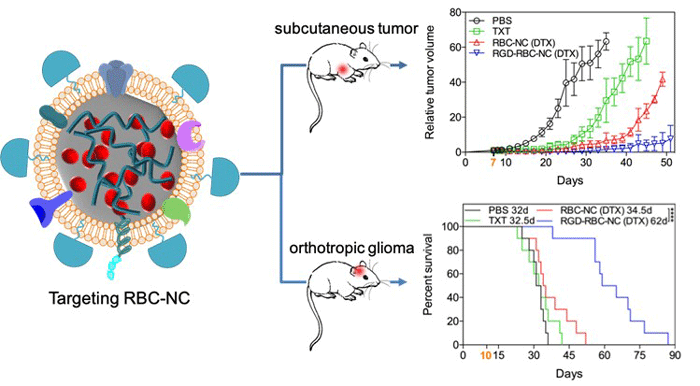
Teams from Fudan University (Prof. Weiyue Lu’s lab) and University of California, San Diego (Prof. Liangfang Zhang’s lab) worked together to develop an active-targeting biomimetic nanomedicine based on red blood cell (RBC) membrane coating-drug nanocrystal (NC) for antiglioma therapy.Recently, this study has been published online by ACS NANO as a research paper named “Ligand-Modified Cell Membrane Enables the Targeted Delivery of Drug Nanocrystals to Glioma”. https://pubs.acs.org.ccindex.cn/doi/10.1021/acsnano.9b00661

Fig. The antitumor efficacy of active-targeting biomimetic nanomedicine with a
single intravenous administration based on subcutaneous tumor and orthotropic glioma.
Currently, surgical treatment remains the first choice of anti-glioma therapy in clinics, with radio- and chemotherapeutics as adjuvant therapy. Due to the lack of clear boundary, a complete resection of glioma tissues in surgeries is difficult, leading to rapid recurrence. Meanwhile, the existence of several physiological barriers in brain and glioma prevented the delivery of chemotherapeutics, resulting in limited drug accumulation in tumor site. High-dose administration brings severe side effects as well. How to increase the drug concentration in glioma site for enhanced efficacy and reduced systematic toxicity? To solve this demanding problem, Prof. Lu’s team led an international coordination, studying on the development of an active-targeting biomimetic nanomedicine. The strategies they used included 1) RBC membrane-coated drug NCs: a combination of prolonged retention time of RBC membranes for improved drug delivery and high drug loading of drug NCs for increased drug concentration in tumor sites; 2) Barrier traverse induced by targeting ligands: modification of glioma-targeting ligand on RBC membrane for nanomedicine accumulation in tumor and tumor cells, and thus enhanced therapeutic efficacy.
The resulting nanomedicine combined the advantages of natural RBC membranes and drug NCs as the outside membranes provided the NC cores with “biomimetic cover”, exhibiting high drug loading, long-term stability, excellent biocompatibility, and prolonged retention time. The modification of targeting peptide c(RGDyK) bestowed the nanomedicine with targeting ability towards both tumor angiogenesis and tumor cells, delivering drugs into tumor site across the blood-brain tumor barrier (BBTB). Therefore, RGD-RBC-NC showed superior therapeutic efficacy and in vivo safety under a high-dose administration of chemotherapeutics. The preparation of this biomimetic nanomedicine is simple and green. This platform is also easy to be industrialized and provides a promising approach towards clinical application.
Zhilan Chai, a PhD student from School of Pharmacy, Fudan University, is the first author of this paper. Prof. Weiyue Lu and Prof. Liangfang Zhang from UCSD are the co-corresponding authors. This work was supported by National Basic Research Program of China, National Natural Science Foundation of China, Shanghai Education Commission Major Project and Shanghai international science and technology cooperation project.